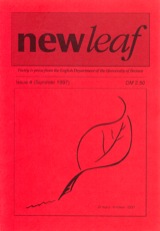editorial

newleaf proudly presents …
We have a logo! Our writing leaf was designed by the young Bremen graphic artist Florian Marski, with whom we hope to co-operate to improve the look of the magazine. At newleaf we work on a shoestring budget. Indeed, when that very first generation of creative writing students were mulling over a title for the project, Shoestring and Apple&Egg (a German-English bi-lingual pun to do with ‘going for a song’) were on the short list. And so far our style has, indeed, been a little cramped: we are not allowed to make a profit, and have to distribute newleaf via our university book shop. In addition, all the printing costs for each new issue have to be covered by the sales of the previous one. But—as you can see—we're working on it. The vagaries of the desktop publishing programmes available to us have also been instrumental in limiting the visual appeal of newleaf. Regardless of how good the contents are—and in this respect we are modestly self-confident—the aura of amateurism is bound to haunt a product that looks homemade or does not feel good in the hand of the book shop customer. This summer we want to look both at the business and technical side of the magazine. Watch this space …
Each issue of newleaf so far has had some kind of thematic thread or threads running through it, a reflection of the fact that many of the texts were written in classes with a topic behind them (Gender, for instance, or The Car and the Planet), or in creative writing classes where a topic has been part of the assignment set. This is less the case this time, but we have tried to link contributions with a thematic cross-reference; thus you will find three poems with a grandmother link together from page six onwards. Then there are the nonsense poems, products of an Introduction to English Poetry seminar in which students were asked to respond to poems by Lewis Carroll and Edward Lear. In turn, one nonsense poem links to the theme of time, which also coloured a couple of classes and produced a poem or two. In one workshop we practised the villanelle, a complicated nineteen-line form which works with a strict structure of repeated lines and only two rhymes, making it very difficult to write (especially in a foreign language). Only three attempts actually made it to the finished product, and they have found their way into newleaf 4. While none of them would claim to match our model—Dylan Thomas's "Do not go gentle into that good night"—they can at least bear comparison with many other published examples of the genre.
newleaf is a Bremen production, even if it is enjoyed by readers all over Germany (and a few in Britain); and one indication that its presence is being felt elsewhere is the number of contributions being sent to us from all over the country. This has presented us with a problem, since our original policy was to remain local. But we shall see. We still have a steady flow of publishable texts from our own Department, a situation which is echoed in the fact that with only three exceptions all our authors this time are members of the Studiengang Englisch. Fiona Metscher, appearing in our pages for the second time, is still at school in the city, Shawn Huelle is a guest student from Nebraska, and Perdita Schulz studies English at our sister university, Oldenburg, just down the road.
Fly leaf, new leaf, fly over newleaf 4 leaf clover: fly.
Simon Makhali and Ian Watson, May 1997
Rosi Oelke
half a dozen, half a dozen
unfrozen
daisies I counted this morning
so spring is performing
contents
-
‘Half a dozen’
-
Love
Robot
Hubertistr. 24
-
Agnes
-
When Granny had Finished her Nap
-
For M.
-
Behind Doors
-
Summer Time — or the Non-Existent Hour
-
When
Doors
-
Tim Giesler, Jason Mullarkey, Arne Sassenberg
-
A Bird's Song
-
Villanelle
-
Dream and Doubt (Villanelle)
-
The Death of Villanelle
-
New surroundings
-
The Ancient Burbtackler
-
Untitled Nonsense
-
Still Life in Water
Time is Flying
-
Monuments
-
After You
-
Affirmation
-
Female Business
Californain Winter Day
-
Inside Out
